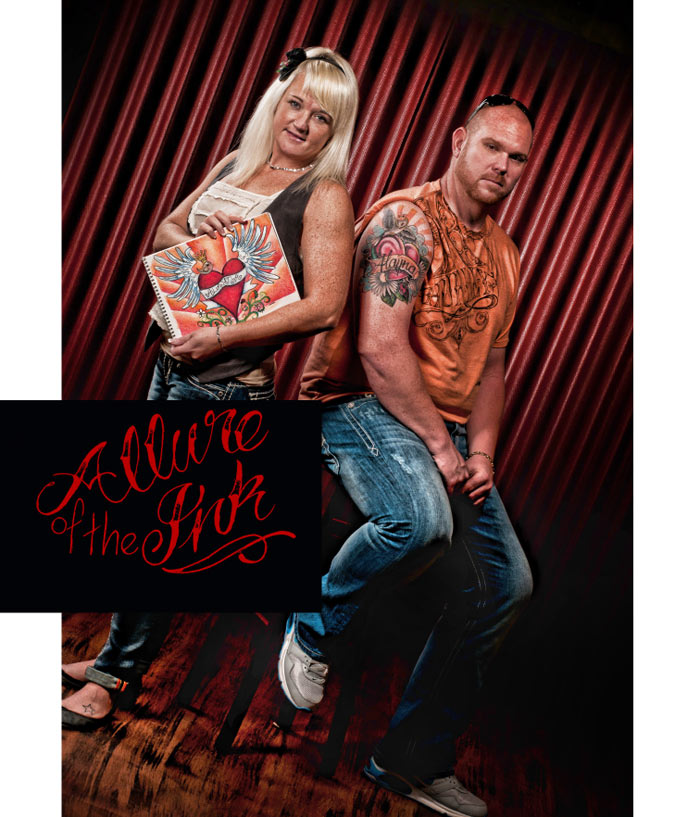
Tyson Wyman studies the colorful drawing, nods and takes a deep breath. “This is better than our original idea,” he says appreciatively.
It’s a sweltering August afternoon, and Tyson has come for his appointment at Fat Kats Artistry Tattoo on the downtown square in Ocala. On the heavy sketch paper in his hands, a cheerful bird wearing a crown perches atop a bold heart. Across the bottom of the heart, the name “Alayna” is gracefully written in a curving banner.
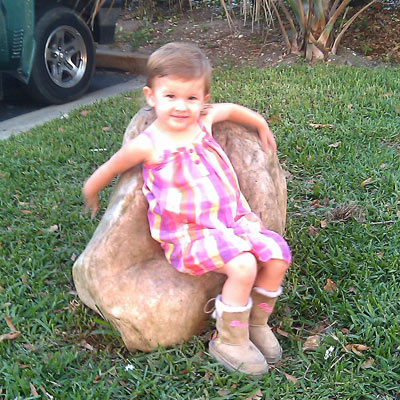
Alayna
“My niece just passed away. She would have been 3 on September 7,” says Tyson in a voice thick with emotion. “I’m getting this tattoo just to have her name near me. I don’t carry pictures in my wallet, so for me, this is a way to keep her close. I also have my daughter’s name tattooed on me.”
Tyson has come to tattoo artist Dan Loose of Fat Kats because his wife previously got a small tattoo from Dan.
“If you’re happy, you stick with the same artist and recommend them to others,” Tyson says. “My wife gave Dan a brief sketch, some suggestions, and then he created a drawing; we’re not changing it at all.”
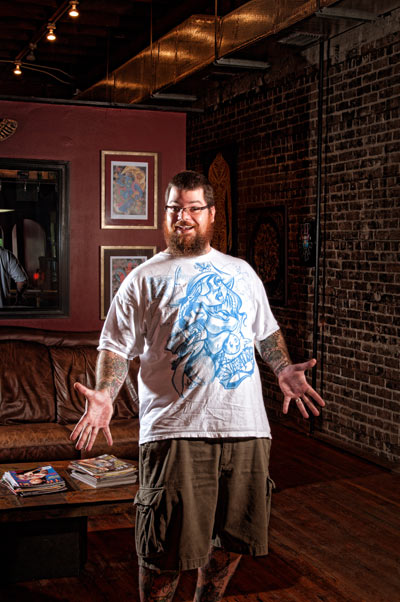
Dan Loose of Fat Kats
“We have general designs, and people like to look at that to get ideas,” says Dan, referring to the displays of pre-designed tattoos known as “flash” on the shop’s wall. “But primarily we do custom tattoos. We do a line drawing of everything, and once the customer requests any changes and then gives the ‘OK,’ we make a stencil and apply it to the skin.”
The stencil leaves a carbon transfer of the image on the skin. From there, the artist inks the outline and proceeds to fill it in with shading, details and any coloring.
Turns out, getting a tattoo is a popular way to memorialize a loved one. This same August afternoon, Austin Cogburn of Dunnellon has walked into the shop wanting a tattoo in honor of her grandfather who passed away last March. Austin, 18, wants a flying eagle in black with gray shading above a banner with her grandfather’s name, and she wants it on her right side.
“He supported me in everything I did,” she says. “He was always right there by my side. It’s what I wanted to do to remember him.”
Within a half hour or less, tattoo artist Alex Ellis, 24, has created a drawing based on Austin’s suggestions. She approves the design, and Alex applies the stencil to her side. Minutes later she’s lying on the table as he begins the tattooing process.
“It’s very important that you hold still,” says Alex, as he picks up his tattoo machine and begins the process. The machine is quiet and only makes a slight hum, similar to the sound of a bee.
“A black and gray tattoo doesn’t have to be as saturated as color, so it tends not to hurt as much,” he says, pausing to dip the needle into the ink. “We use different size needles, depending on the width of lines and shading. The needle actually pushes the pigment into the skin as you go.”
“It doesn’t really hurt,” says Austin, sounding relieved. “It feels like being scratched with a pin.”
“We’re not digging for gold,” says Alex, who was a graphic designer before he got into tattooing. “The needle just goes down through a couple layers of skin; it’s not very deep, maybe an eighth of an inch.”
Watching Austin gain her flying eagle in honor of her grandfather, I had no desire to get a tattoo of my own. But I must admit, when I accepted the assignment to write a feature on tattooing, I was intrigued. Although I’m probably the least likely person to grace the doors of a tattoo shop, I was eager to learn just what’s behind the popularity of this centuries-old technique that has recently become much more mainstream. While I remain “ink-free” at the end of my story, I do have a greater understanding of why so many people have chosen this style of body art.
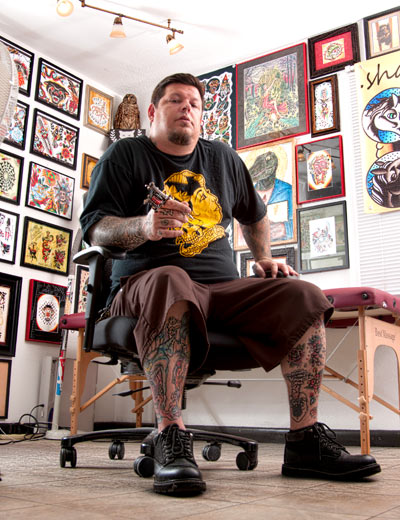
Chris O’Leary of Ocala Tattoo
“Tattoos are a luxury item, but business is still doing well, even in a recession,” says Chris O’Leary, 39, owner of Ocala Tattoo, Inc., which marks its six-year anniversary this month.
“You’re investing in something permanent. Even if you spend thousands to buy a car, it’s not going to last forever, but a tattoo will,” notes Tim Shafer, 24, one of the tattooists at Ocala Tattoo.
He’s got a point. But what’s really behind the recent increase in popularity of tattoos?
According to tattooartist.com, tattooing is currently the sixth-fastest growing retail business in the United States. Once relegated to bikers, military men, rockers and rebels, tattooing is attracting an ever-widening array of clientele. Fashion models, sports professionals, and movie and rock stars often flaunt tattoos, but they’re hardly alone.
A 2006 study conducted by the Journal of the American Academy of Dermatology revealed that 24 percent of Americans ages 18 to 50 have tattoos, and approximately 36 percent of Americans ages 18 to 29 have at least one tattoo. Middle-class suburban women (think “soccer moms”) are the fastest-growing demographic group seen in tattoo shops around the country. What was once an anti-social activity is now viewed by many as a form of art and a legitimate profession.
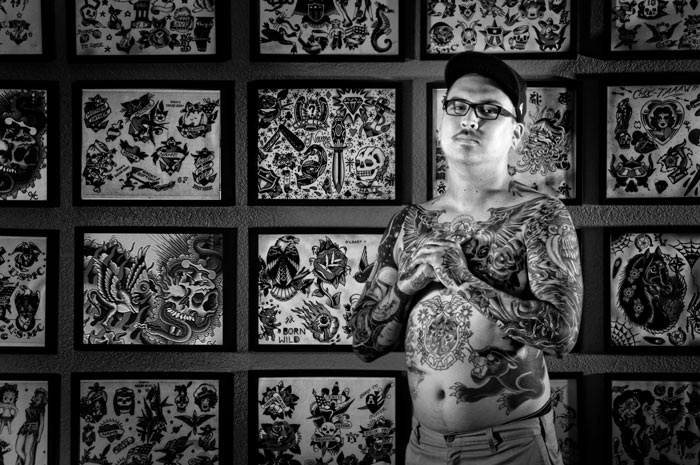
Tim Shafer of Ocala Tattoo
“You’d be surprised who has them. A very strong demographic is 20- to 40-year-old women,” notes Tim. “It’s becoming a novelty to get at least one tattoo. I’ve tattooed grandmothers in their 60s and 70s getting their first tattoos.”
“Tattoos are more accepted than they were 20 years ago,” Chris agrees. “I got tattoos as a youth because I purposely wanted to alienate myself; I didn’t want to be messed with. I’ve had my right arm covered since I was 18; I never gave myself a chance at normalcy. When I first got into tattooing, I did it for me. When you’re 16, you can’t see 30. Twenty-some years later, I realize I don’t want to be remembered for my tattoos but for keeping alive traditional American tattooing.”
Simple, bold designs with solid black lines and heavy shading are the trademark of “traditional American” tattoos, which Chris’ shop specializes in. They tend to last longer than those done with finer lines and color.
“In America, tattoos were originally based around the basics of life: love, lust, patriotism and death. In the early days, those motifs were seen as roses, skulls and hearts—what you traditionally think of as ‘sailor tattoos,’” explains Mark Willis, a tattooist at Ocala Tattoo.
Mark, 22, has been tattooing professionally for two years, ever since he finished his apprenticeship.
“Any respectable tattoo artist needs an apprenticeship. If you’re trying to have integrity in your work, you need to be taught. Safety and cleanliness are part of the apprenticeship,” he says. “Tattooing is not something to dabble in, because your ‘mistakes’ are permanent. It’s a lifestyle, not a hobby. We’re doing something that has been passed down, and I think it’s important for us to carry on the classic style.”
Always interested in art, Mark got his first tattoos at age 17.
“I did it to make myself ineligible for acceptance because I wanted to be left alone,” he says. “I was rebelling against society—not my parents. I got heavily tattooed before becoming a tattooist. I was tired of having job after job I hated. Now I’m settled in a career, getting paid to do what I love, and I didn’t have to go through the steps conventional society would tell me to take, such as college.”
A majority of tattoo artists are walking advertisements for their profession.
“Most tattoo artists wear what they do; I know a couple who don’t have any that show, but that’s not the norm,” says Dan of Fat Kats, which is coming up on its 11th year in business.
“I’ve been drawing since I could hold a pencil,” adds Dan, 34, who took commercial art classes in high school and has been a tattoo artist for 16 years. “I practiced on myself when I first started, but I don’t tattoo myself anymore. I save what space is left to get tattoos by other artists. The art’s gotten so much better in the last 10 years; some of these artists are really talented.”
As Chris at Ocala Tattoo points out, it takes more than artistic ability to become a success in this field.
“The yin and yang of the perfect tattoo is the artwork and the application. I know guys who are phenomenal artists, but because they don’t understand the rules and don’t know how to apply it to skin, they’ll fall short. A true tattoo artist has mastered both the mechanics and the art of it.”
“You never want to sacrifice good technique just for art,” adds Mark.
None of the tattoo artists interviewed had anything good to say about the current crop of tattoo shows on television. They consider them “full of drama” and not a positive representation of the industry.
Tattoos can be highly personal, as are the reasons for wanting one (or many).
For Jeremy and Jessica Smith of Ocala, their tattoos are symbols of faith and love. Jeremy, 36, is self-employed and owns Modern Edge Decorative Concrete; Jessica, 30, is a school teacher.
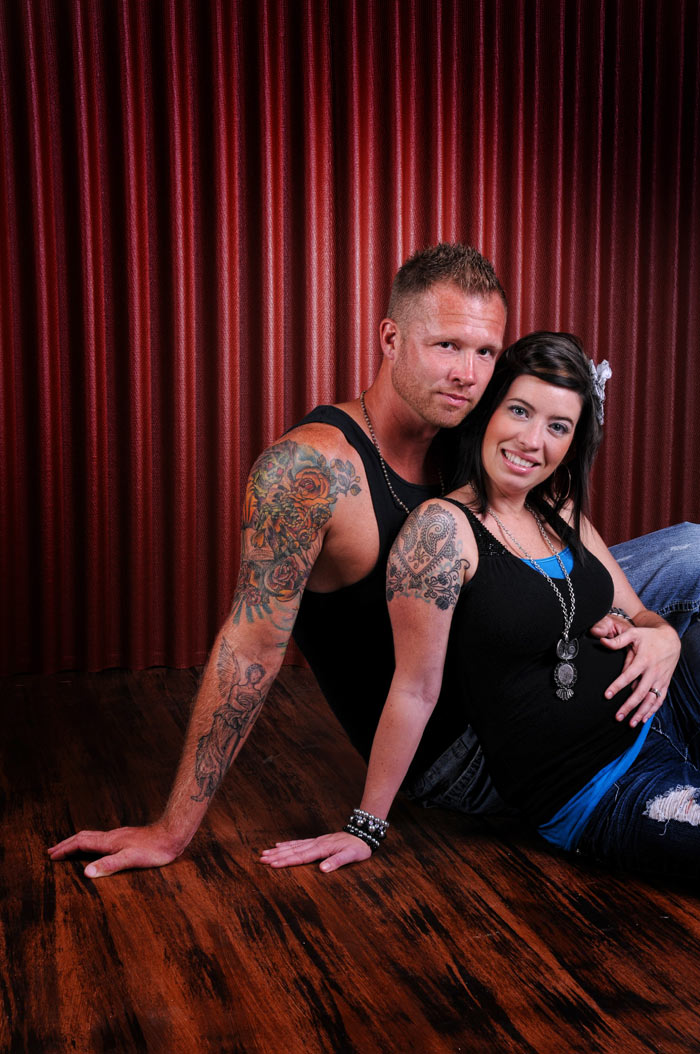
Jeremy and Jessica Smith
On her right upper arm, Jessica has a large, intricately detailed heart containing two paisley designs. “It signifies that Jeremy and I were two separate beings and have come together as one united by God and love,” she explains. “Also in the heart is a flower that represents our forever growing love.”
For Jeremy, his tattoos tell his life story in a nutshell. On his upper right arm, the grim reaper holds a rope that is attached to an anchor sunk into a Bible upon which is written Proverbs 3:5. A twisted oak tree bearing the image of a man and woman symbolizes his marriage to Jessica, while the bird in the branches and shooting star beyond the tree represent his daughter and son. An angel is prominently displayed inside Jeremy’s forearm.
“I made poor decisions in my past that led me down a rough road that left me vulnerable for addictions, wrong relationships and dangerous situations, but I always felt God has appointed a guardian angel to look after me. People will look at my tattoos, see the Scripture and ask about the meaning,” says Jeremy, who didn’t get his first tattoo until he was in his 30s. “I absolutely got them as an expression of my faith and the things that are important in my life: God and my family.”
“People judge you, and everyone has their own opinion, but it doesn’t change who we are and how we live,” says Jessica. “Our tattoos have stories behind them; they’re just expressions we choose to present in a way that people can see.”
Some tattoos are clearly for shock value, while others are hidden under clothing much of the time.
“I have a friend who’s an elementary school teacher and has a full sleeve tattoo on one arm,” says Tim. “She just wears long sleeves to work all the time. No one she works with knows she has it.”
So, are tattoo artists willing to apply tattoos to anyone who has the money to pay for it? Talking with the five tattooists I interviewed, I found some have very definite lines they won’t cross. Dan, for example, won’t tattoo anything devil-related, as it goes against his beliefs. None of the artists would tattoo gang-related symbols, and they also shy away from tattooing things that could be considered racist. No reputable shop will tattoo someone under 16, nor will they tattoo anyone who comes in under the influence of drugs and/or alcohol.
“If someone comes in and wants to get their hands tattooed, we talk to them about it,” says Mark. “We tell them to really think about it because it can affect their job and how people look at them.”
A pot leaf on your neck? Not a good idea, according to Chris. “A tattoo can change your life socially. You get the wrong tattoo in the wrong place and you’re alienated forever.”
Inappropriate images aside, tattoo artists as a whole are proud of what they do.
“I’ve always wanted to do something with art, and this is what I’ve found I like to do best,” Dan says thoughtfully. “You’re never doing the same thing twice, and you’re always dealing with different people. They’re going to carry your mark with them for the rest of their life, hopefully, in a good way.”
For Tyson Wyman, that is definitely the case.
“It’s a beautiful tattoo, and I’ve gotten a lot of positive responses, although that was never my goal,” he says modestly. “A lot of people have seen it on Dan’s Facebook page and didn’t know the story behind it. My family loves it, and Alayna’s family loves it, but I’m just amazed at the responses I’ve gotten from people who don’t even know me. It turned out better than I could have expected.”
An Ancient Artform
One of the world’s oldest forms of body modification, tattooing has been practiced for thousands of years. For example, there were times when the Egyptians tattooed the names or symbols of their deities on their arms or chest. The Israelites, however, were forbidden to engage in this practice, following a command found in Leviticus 19:28 (NWT), which states “And you must not make cuts in your flesh for a deceased soul, and you must not put tattoo marking upon yourselves.” This law is still observed today by some modern day Jews and some Christian religions.
Done by hand for centuries, most artists today use hand-held, electrically powered machines. Invented in the late 1800s, tattoo machines have not changed greatly, although technique, ink and safety procedures have improved dramatically.
Similar to a tiny sewing machine, the tool causes a sterilized needle to rapidly move up and down as many as several hundred to thousands of times per minute. The artist dips the needle into insoluble ink, which is then drawn up into the machine’s tube. As the needle penetrates the skin, it carries the ink below the surface to a depth of about one-eighth of an inch.
So, how much does it hurt?
“A common comparison for some people is that tattoos are similar in feeling to a cat scratch or bad sunburn,” says Alex Ellis of Fat Kats. “It’s a common misconception that if it’s over muscle, it will be OK and if it’s over bone, it will hurt more. Certain areas—such as feet and ribs—are more painful than others, but it varies. On the same person, one foot may be more sensitive than the other.”
Investigate Your Ink
Do your homework before deciding where to get a tattoo. Get an idea of the style you like, visit different shops, look through the artists’ portfolios and check for cleanliness. Don’t hesitate to ask to see the autoclave, which is where equipment is sterilized for safety. There are steam and chemical autoclaves, but steam is the preferred type in the world of tattooing. A temperature of no less than 246 degrees must be maintained for 30 minutes or equipment isn’t fully sterilized.
Needles should always be single-use and disposable. Any reusable equipment, such as ink tubes, should be in individual sterile pouches before the artist begins working. Needles, grommets, rubber bands, ink caps and any excess ink should be thrown away after each use. The tattoo artist should wear new gloves with each job, and everything touched during the process should be wiped clean with a germicidal disinfectant. Many artists have taken classes in blood-borne pathogens to increase their knowledge about safety procedures.
“We strive for professionalism,” says Tim Shafer of Ocala Tattoo. “You wouldn’t go to someone’s house to get dental work done, so you shouldn’t go to someone’s house to get a tattoo.”
It may seem like a no-brainer, but take time to carefully study the artists’ portfolios before deciding who’s going to ink you. Ask friends with tattoos you like for artist recommendations. Once an artist has created a drawing, speak up if there’s anything you don’t like or aren’t sure about. After all, this artwork is going to be permanently displayed on your body.
Tattoo shops typically require customers to complete a “hold harmless” agreement stating you’re there of your own free will. In Florida, you must be 18 to get a tattoo without parental consent. If you’re 16 or 17, you’ll need a parent to come in and sign their permission.
Price Points
Tattoo shops usually price tattoos one of two ways: flat fee or hourly.
As the words imply, a flat fee is the total price you’ll pay. This is usually how “flash” (pre-designed art displayed in the shop) is priced. If you want modifications or a different size, this may affect the fee. Generally speaking, a black/gray tattoo costs less than one with color, but that depends on size and complexity.
Many customers want custom art, and this is typically charged on the amount of time it takes. Multiple sessions may be needed to complete a large and/or especially detailed tattoo. Hourly fees vary, depending on the shop and artist. Generally speaking, $100 an hour is a good average price. Artists typically work on a percentage basis with the shop.
After The Ink
When you get a tattoo, you are intentionally wounding your skin, so after care is important in order to avoid infection or complications. As eager as you are to show off a new tattoo, leave the bandage on for several hours and follow care advice given by the tattoo shop.
“I recommend leaving it on for 12 hours. It’s best not to re-bandage once you remove the original,” says Dan Loose of Fat Kats. “Then, wash the area two to three times a day with warm water and a mild antibacterial soap. Pat it dry and put ointment on it two to three times a day. After three days, you can switch to plain white hand lotion (dye-free and fragrance-free), and apply that until it’s healed, which averages five to 10 days.”
There are products made specifically for tattoos, such as Tattoo Goo and H2Ocean, but over-the-counter products are fine. Don’t, however, use Neosporin ointment on a new tattoo, as it can cause reactions and leave tiny “polka dots” on the healed tattoo.
Showering is fine, but don’t swim with a new tattoo for two weeks. You’ll want to keep it out of the sunlight until completely healed and then apply a sunscreen of SPF 30 when spending much time outdoors. Those ultraviolet rays can seriously fade tattoos, so if you want yours to stay vibrant and bright for years to come, stick with the sunscreen.
Eliminating The Ink
Career concerns, relationship change, poor artwork, conspicuous location—all can be reasons for wanting to remove a tattoo. Keep in mind that getting rid of something designed to be permanent isn’t easily done. Laser surgery is popular for removing unwanted tattoos, but it takes multiple visits and can cost thousands of dollars. In addition, it can be painful and cause scarring.
There are a number of tattoo fade creams on the market that have had success. Some options are Tat-Med, Profade, Tat B Gone, Tattoo-off and Dermasol, to mention a few. Experts caution against using products that contain hydroquinone and TCA (trichloroacetic acid). Hydroquinone has been linked to cancer and is banned is several countries.






